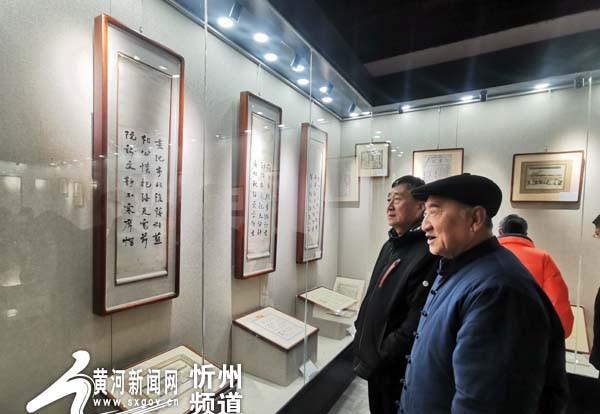
——Ning Chaowu calligraphy four screen appreciation
In the western display cabinet of the Xiurong String Song Hall of the Xinzhou Xiurong Academy Museum, there are four screens of calligraphy of the former Xianning Chaowu. Its characters are calligraphy, the font is pharaoh, dignified and beautiful, and has won the praise of most visitors since its exhibition. A few days ago, Mr. Liu, a collector in the provincial city of Taiyuan, also came to see this group of collections.
Ning Chaowu , Zi Gao , Pu Zhai , ancestral home of Songtai Village, Wutai County, Shanxi. During the Guangxu period of the Qing Dynasty, his ancestors and his wife Zhao moved to the village of Paozhanggou at the foot of the Wufeng Mountains in western Xinzhou, where they settled in Xinzhou. Ning Chaowu was gifted and intelligent from an early age, diligent and studious, and was a student of Xinxian Middle School during the Republic of China, and was later admitted to Shanxi University with excellent results. In 1920 he was sent to Keio University in Japan to specialize in philosophy. After returning to China, he served as the director of the Taiyuan Appeasement Office in Shanxi, the secretary general of the Shanxi Provincial Government, and the director of the Provincial Literature Committee. Ning Chaowu is knowledgeable and good at poetry, and is a famous contemporary calligrapher.
These four screens are three of Ning Chaowu's poems in the Qing Dynasty calligraphy master He Shaoji's "Forty Absolute Sentences of Jinling Miscellaneous Sentences", the content of which is as follows:
One
Along the river, there is no willow swaying, and it is walking towards the Qingxi Longban Bridge.
The T-shaped curtain is still in front of it, and who gossips to the Southern Dynasty.
Two
Bo traveled to Jiangnan and heard that Tianliu Miaoxiang'an was said.
Begonia empty monks are gone, and the pond pavilion is not restored to the old essence blue.
Third
Xiang Gong embraced the sea and the sky wide, and the festival papers were not cold.
The hats are gathered together, and the old rain is followed by the new joy.
He Shaoji, Zizhen Zizhen, Dongzhou Resident, a native of Daoxian County, Hunan, was a scholar in the sixteenth year of Daoguang (1836), and successively served as an editor of the National History Museum and a scholar of Sichuan. He is knowledgeable about the history of scriptures, poetry and literature, and he is a generation of calligraphers and painters. "Forty Sentences of Jinling Miscellaneous Sentences" is a poem created by He Shaoji when he traveled to Jinling in his later years, all of which are seven-character poems. Looking at He Shaoji's "Forty Absolute Sentences of Jinling Miscellaneous", it can be said that the poetry books are excellent and complement each other. Because this group of poems was composed during his travels in Jinling, the content of the poems is more about writing scenes, but the grammar is neat and rigorous, the sentences are vivid, and the lyricism is particularly in place, highlighting his high academic knowledge and literary creation.
From a calligraphic point of view, the "Forty Sentences of Jinling Miscellaneous Sentences" can be called a representative work of He Shaoji's handwriting codex in his later years. He was sixty-six years old when he wrote and wrote this group of poems, at the height of the art of calligraphy. This work can be said to embody his lifelong technical accumulation and emotional experience, and the words reflect the literati feelings of his era. The forty poems throughout the poem are naturally sprinkled, and each poem is followed by a small character marked with a point or impression of the poem, and the relationship between words and words, lines and lines is close, giving people a simple and beautiful sense of breath and natural beauty. The late Qing Dynasty calligrapher and epigrapher Mo Youzhi once wrote after his poem: "The light is innocent and transcendent, and it is possible to get rid of all the paths of the calligrapher, and Gais you is extremely proud of the book." ”
The aesthetic characteristics of He Shaoji's calligraphy reflect the beauty of "thick" and "lingxiu", forming his own unique style, which has had a profound impact on the style of writing in later generations, and can be called a generation of masters in the late Qing Dynasty.
Ning Chaowu loved calligraphy all his life, he especially liked the words of his predecessor He Shaoji, and when he was young, he insisted on sticking to it for six years, and in today's words, he was a "hardcore fan" of He Weng. In his later years, he integrated the writing styles of Yan Zhenqing and He Shaoji, and also became a self-contained and respected by posterity. Carefully tasting these four screens, it is not difficult to see that the essence of He Weng's year is in its dot-point structure.
At the end of the four screens of Ning Chaowu's calligraphy, there is a line inscription "Mirror like my brother Yazheng, brother Chaowu". From the drop of these few words, we know that this is what Ning Chaowu wrote to the same window Xueyou Zhijingru. Zhi Jing ru Zhi Chengye, a villager from Xinxian County, founded the Northwest Correctional Institution in Hanzhong, Shaanxi during the War of Resistance Against Japanese Aggression, rescued and raised nearly 3,000 orphans who were in distress, and received attention and funding from Politicians of the Republic of China such as Song Qingling and Yu Youren, and was praised by the whole society at that time.
Ning Chaowu and Zhijingru are both outstanding students who came out of Xinxian Middle School during the Republic of China period, and these four screens can be said to be a testimony of the graduates of Xinxian Middle School forging ahead with each other, and they are also important collections of Xiurong Academy Museum. (Text/Zhang Liujin Photo/Liang Shengzhi)